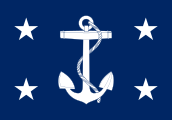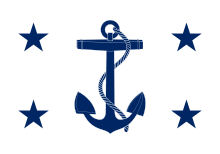David Sinton Ingalls
| David Sinton Ingalls | |
|---|---|
|
Lieutenant David Ingalls c.1918 | |
| Born |
28 January 1899 Cleveland, Ohio, United States |
| Died |
26 April 1985 (aged 86) Chagrin Falls, Ohio, United States |
| Buried at | Hot Springs, Virginia, United States |
| Allegiance |
|
| Service/branch | United States Navy |
| Years of service |
1917–1919 1941–1945 |
| Rank | Rear Admiral |
| Unit |
No. 217 Squadron RAF No. 213 Squadron RAF |
| Battles/wars |
World War I World War II |
| Awards |
Navy Distinguished Service Medal Legion of Merit Distinguished Flying Cross (United Kingdom) Mentioned in Despatches (United Kingdom) Legion d'Honneur (France) |
| Other work | Assistant Secretary of the Navy |
David Sinton Ingalls (28 January 1899 – 26 April 1985) was the US Navy's only flying ace of World War I, with six credited victories;[1] thus he was the first ace in U. S. Navy history.[2] He was the son of Albert S. Ingalls; his mother, Jane Taft, was the niece of President William Howard Taft. He was the grandson of railroad executive Melville E. Ingalls.[3] He was the great-grandson of industrialist David Sinton, for whom he was named. He was married to Louise Hale Harkness, daughter of William L. Harkness and granddaughter of Daniel M. Harkness, who was instrumental in the formation of Standard Oil.
Education
Ingalls received his secondary education at the University School in Cleveland, and later attended St. Paul's. He entered Yale in 1916, where he studied as a medical student (he would eventually graduate in 1920 with a BA in English) and joined the First Yale Unit.[4] As such, Ingalls became a member of the Naval Reserve Flying Corps and by 1917 had obtained his pilot's license.
Military career
Training
On 26 March 1917, Ingalls was enlisted as Naval Aviator No. 85.[5] He was called to active duty on 4 April 1917. Before heading to Europe, Ingalls received aviation training at West Palm Beach in Florida. On 3 June, he was sent to Huntington, Long Island, New York for more training. His training was completed on 1 September 1917, and he was made a lieutenant (junior grade).
Ingalls arrived in Paris on 12 September 1917 and reported to the Commander of United States Naval Forces Operating in European waters in London on 10 December 1917 and was sent to the RFC training facility at RAF Gosport from 13 December 1917 until February 1918.[4] From there, he went to the RFC Station in Ayr for squadron formation flying. On completion of this course, he was sent to Paris and arrived in Dunkirk on 18 March 1918. From Dunkirk he went to Clermont for a course in flying day bombing and gunnery. He arrived back in Dunkirk on 2 July, where he was attached to 213 Squadron of the Royal Air Force.
Operational activity
Ingalls was attached to the British 213 Squadron and flew Sopwith Camels in attacks on German submarine bases. He was temporarily reassigned to No. 17 Naval Squadron to gain experience flying bombers, between April and August 1918. Once back with 213 Squadron, Ingalls began tallying victories. On 11 August 1918, Ingalls and his flight leader, Colin Peter Brown, shot down a German observation plane behind enemy lines.[6] Two days later, he was involved in a surprise attack on a German aerodrome, which destroyed thirty-eight planes. On 21 August, Ingalls shared a win over an LVG two-seater with Brown and fellow ace George Stacey Hodson.[6]
On 15 September, he destroyed a Rumpler in company with fellow ace Harry Smith. Three days later, he teamed with Smith and Hodson to become a balloon buster. Two days after that, Ingalls lost his engine and knew he had to crash land. As he was descending, he saw a woman sitting in a field smoking a pipe. He had never seen a woman smoking a pipe, so he tried to land in that field. Then his engine kicked back in and he was able to fly again. But by now he was well behind enemy lines. As a result, he was able to come at the Germans from behind and destroy a Fokker D.VII to become an ace.[6] On a later attack on a German aerodrome, Ingalls destroyed more planes. On his way back to base on 24 September 1918, he spotted a German observation plane, which he and Hodson shot down.[6] His last flight of the war came on 3 October 1918.
The following day, he headed home and was awarded the Navy Distinguished Service Medal for exceptionally and meritorious Service as chase pilot operating with No. 213 Squadron RAF while attached to the Northern Bombing Group. Ingalls was also decorated by Great Britain with the Distinguished Flying Cross and by France with the Legion of Honour. On 1 January 1919, he was also Mentioned in Despatches by the British.[7] He was released from the military on 2 January 1919.
Post-war
Ingalls returned to Yale and received an LLD from Harvard in 1923. After graduating, he joined Squire, Sanders & Dempsey as an associate. In 1926, he was elected to the Ohio General Assembly, where he co-sponsored the Ohio Aviation Code. Ingalls also served as a member of the Ohio House of Representatives from 1927 to 1929. He was a good friend of Jack Towers, who recommended Ingalls for the job of Assistant Secretary of the Navy (AIR). He asked Newton Baker, a friend of his father to recommend him to Herbert Hoover. He got the job in early 1929. He became a good friend of Hoover, who invited him to the White House and to his camp. Fellow Bonesman F. Trubee Davison would often accompany them. On his way home in his plane from Washington in June 1929, Ingalls crashed his plane into a fence, but was unharmed. As Assistant Secretary, he tripled the number of naval aircraft and pushed for a fully deployable carrier task force. In 1932, he embarked on an unsuccessful campaign to become Governor of Ohio. He left in 1933 to become director of Cleveland's Department of Public Health and Welfare.
In the mid-1930s, Ingalls was appointed a lieutenant commander in the Naval Reserves. He was made Vice President and General Manager of Pan Am Air Ferries in 1941. After the attack on Pearl Harbor by the Japanese, he helped develop the Naval Air Station at Honolulu, and ended up reporting for duty. In 1943, he became Chief of Staff for the Forward Area Air Center Command and later Commander of the Pearl Harbor Naval Air Station.
Other interests
On his return to Ohio, he became a director of Pan Am World Airways and managed Robert A. Taft's campaign to be the Republican nominee for president in 1952. In 1954, he became President and publisher of the Cincinnati Times-Star and Vice Chairman of the now defunct Taft Broadcasting Company. He left the Cincinnati Times-Star in 1958 to practice law.
Ingalls was a friend of the aviator Charles Lindbergh, whom he helped solve navigation and communication problems in charting new air routes to the east for Pan Am.
He was a director of the Cleveland Trust Company, director of South Eleuthera Properties, Vice President of Virginia Hot Springs, Inc., President of the Central Eyebank for Sight Restoration, trustee of Laurel School and an honorary trustee of the Young Men's Christian Association.
Ingalls was a member of the American Legion, Chagrin Valley Hunt Club, Freemasons, Jekyll Island Club, Kirtland Country Club, Pepper Pike Club of Pepper Pike, Queen City Club of Cincinnati, River Club of New York, Skull and Bones and the Union Club of Cleveland.
Ingalls was a sportsman and a co-owner of two quail plantations: Ring Oak Plantation and Foshalee Plantation, which he shared with Robert Livingston Ireland, Jr.[8]
The Ingalls Hockey RInk aka The Whale at Yale University is named after David Ingalls as well as his son, David S. Ingalls, Jr. and the Ingalls family were the primary benefactors of the rink.
See also
References
- Citations
- ↑ Airfields & Airmen of the Channel Coast: Battleground I Battleground Europe Series. pp. 61–62.
- ↑ http://www.theaerodrome.com/aces/usa/ingalls.php Retrieved 3 March 2010.
- ↑ "MELVILLEE. INGALLS, FINANCIER, IS DEAD". The New York Times. July 12, 1914. p. C5.
- 1 2 O'Connor, M, p.61
- ↑ American Aces of World War I. p. 45.
- 1 2 3 4 http://www.theaerodrome.com/aces/usa/ingalls.php Retrieved on 20 June 2010.
- ↑ The London Gazette: (Supplement) no. 31098. p. 102. 1 January 1919. Retrieved 2009-01-25. For distinguished service in war areas – Lieut. David Sinton Ingalls, DFC, USA Air Service (Attached RAF., Flanders)
- ↑ From Cotton To Quail: An Agricultural Chronicle of Leon County, Florida, 1860–1967. pp. 91–92.
- Bibliography
- Airfields & Airmen of the Channel Coast: Battleground I Battleground Europe Series". Mike O'Connor, Michael O'Connor. Pen & Sword Books, 2006. ISBN 1-84415-258-8, ISBN 978-1-84415-258-2.
- American Aces of World War I. Norman Franks, Harry Dempsey. Osprey Publishing, 2001. ISBN 1-84176-375-6, ISBN 978-1-84176-375-0.
- From Cotton To Quail: An Agricultural Chronicle of Leon County, Florida, 1860–1967, Paisley, Clifton. University of Florida Press, 1968. ISBN 978-0-8130-0718-2
External links
| Government offices | ||
|---|---|---|
| Preceded by Edward Pearson Warner |
Assistant Secretary of the Navy (AIR) March 16, 1929 – June 1, 1932 |
Succeeded by Artemus Gates |
| Party political offices | ||
| Preceded by Myers Y. Cooper |
Republican Party nominee for Governor of Ohio 1932 |
Succeeded by Clarence J. Brown |



